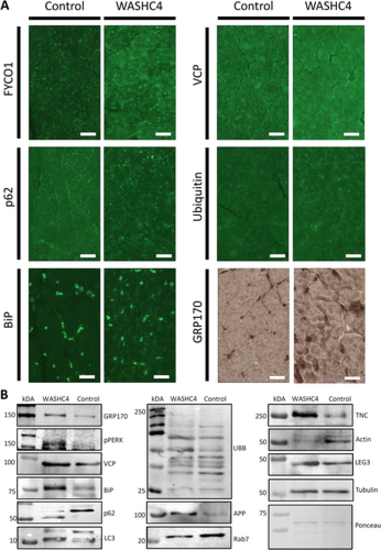FIGURE
Fig. 4
- ID
- ZDB-FIG-230114-12
- Publication
- Gangfuß et al., 2021 - Homozygous WASHC4 variant in two sisters causes a syndromic phenotype defined by dysmorphisms, intellectual disability, profound developmental disorder, and skeletal muscle involvement
- Other Figures
- All Figure Page
- Back to All Figure Page
Fig. 4
|
Immunological studies on WASHC4 patient-derived quadriceps muscle. (A) Immunostaining of FYCO1, p62, VCP, ubiquitin, BiP, and GRP170 reveals increased sarcoplasmic immunoreactivity in WASHC4-mutant muscle fibers. Scale bars = 30 μm. (B) Immunoblotting results confirming the increase of FYCO1, p62, VCP, ubiquitin, BiP, and GRP170 in whole protein extracts of the WASHC4 patient-derived muscle. LC3 showed an increased conversion from LC3-I to LC3-II in the WASHC4 patient-derived muscle. p62 showed a band at a lower molecular weight compared with the control. Additionally, there were increases of galectin-3 (LEG3), phospho-PERK (pPERK), and amyloid, as well as decreases of Rab7, actin, and tenascin (TNC). Ponceau staining of a representative nitrocellulose membrane demonstrates equal protein loading.
|
Expression Data
Expression Detail
Antibody Labeling
Phenotype Data
Phenotype Detail
Acknowledgments
This image is the copyrighted work of the attributed author or publisher, and
ZFIN has permission only to display this image to its users.
Additional permissions should be obtained from the applicable author or publisher of the image.
Full text @ J. Pathol.

